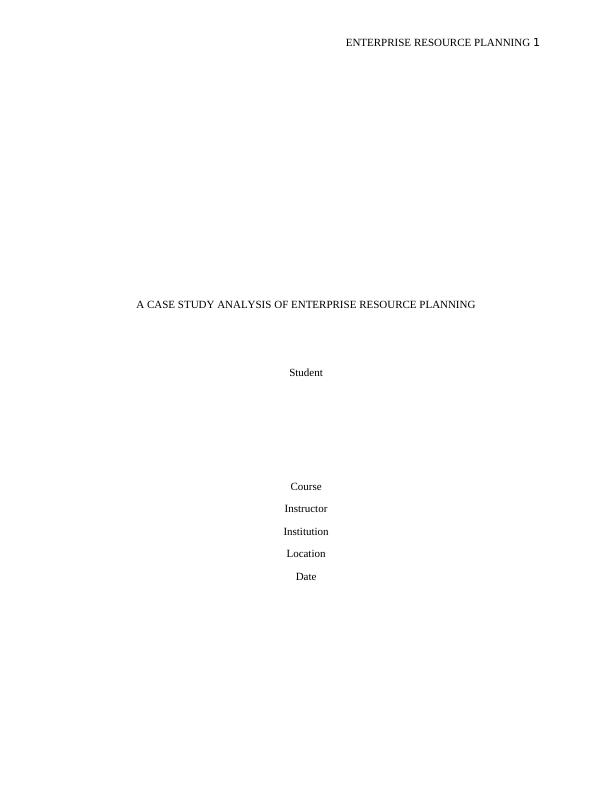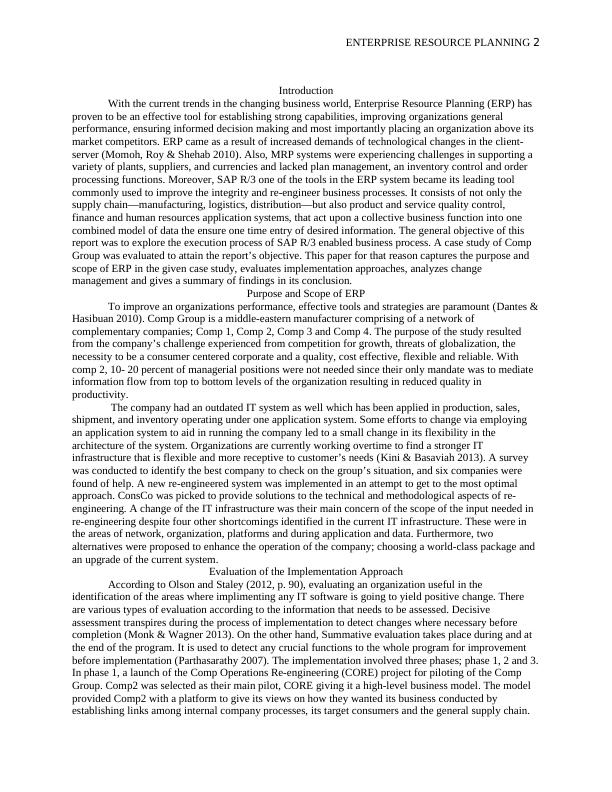A Case Study Analysis of Enterprise Resource Planning
Added on 2022-12-20
4 Pages1720 Words49 Views
ENTERPRISE RESOURCE PLANNING 1
A CASE STUDY ANALYSIS OF ENTERPRISE RESOURCE PLANNING
Student
Course
Instructor
Institution
Location
Date
A CASE STUDY ANALYSIS OF ENTERPRISE RESOURCE PLANNING
Student
Course
Instructor
Institution
Location
Date

ENTERPRISE RESOURCE PLANNING 2
Introduction
With the current trends in the changing business world, Enterprise Resource Planning (ERP) has
proven to be an effective tool for establishing strong capabilities, improving organizations general
performance, ensuring informed decision making and most importantly placing an organization above its
market competitors. ERP came as a result of increased demands of technological changes in the client-
server (Momoh, Roy & Shehab 2010). Also, MRP systems were experiencing challenges in supporting a
variety of plants, suppliers, and currencies and lacked plan management, an inventory control and order
processing functions. Moreover, SAP R/3 one of the tools in the ERP system became its leading tool
commonly used to improve the integrity and re-engineer business processes. It consists of not only the
supply chain—manufacturing, logistics, distribution—but also product and service quality control,
finance and human resources application systems, that act upon a collective business function into one
combined model of data the ensure one time entry of desired information. The general objective of this
report was to explore the execution process of SAP R/3 enabled business process. A case study of Comp
Group was evaluated to attain the report’s objective. This paper for that reason captures the purpose and
scope of ERP in the given case study, evaluates implementation approaches, analyzes change
management and gives a summary of findings in its conclusion.
Purpose and Scope of ERP
To improve an organizations performance, effective tools and strategies are paramount (Dantes &
Hasibuan 2010). Comp Group is a middle-eastern manufacturer comprising of a network of
complementary companies; Comp 1, Comp 2, Comp 3 and Comp 4. The purpose of the study resulted
from the company’s challenge experienced from competition for growth, threats of globalization, the
necessity to be a consumer centered corporate and a quality, cost effective, flexible and reliable. With
comp 2, 10- 20 percent of managerial positions were not needed since their only mandate was to mediate
information flow from top to bottom levels of the organization resulting in reduced quality in
productivity.
The company had an outdated IT system as well which has been applied in production, sales,
shipment, and inventory operating under one application system. Some efforts to change via employing
an application system to aid in running the company led to a small change in its flexibility in the
architecture of the system. Organizations are currently working overtime to find a stronger IT
infrastructure that is flexible and more receptive to customer’s needs (Kini & Basaviah 2013). A survey
was conducted to identify the best company to check on the group’s situation, and six companies were
found of help. A new re-engineered system was implemented in an attempt to get to the most optimal
approach. ConsCo was picked to provide solutions to the technical and methodological aspects of re-
engineering. A change of the IT infrastructure was their main concern of the scope of the input needed in
re-engineering despite four other shortcomings identified in the current IT infrastructure. These were in
the areas of network, organization, platforms and during application and data. Furthermore, two
alternatives were proposed to enhance the operation of the company; choosing a world-class package and
an upgrade of the current system.
Evaluation of the Implementation Approach
According to Olson and Staley (2012, p. 90), evaluating an organization useful in the
identification of the areas where implimenting any IT software is going to yield positive change. There
are various types of evaluation according to the information that needs to be assessed. Decisive
assessment transpires during the process of implementation to detect changes where necessary before
completion (Monk & Wagner 2013). On the other hand, Summative evaluation takes place during and at
the end of the program. It is used to detect any crucial functions to the whole program for improvement
before implementation (Parthasarathy 2007). The implementation involved three phases; phase 1, 2 and 3.
In phase 1, a launch of the Comp Operations Re-engineering (CORE) project for piloting of the Comp
Group. Comp2 was selected as their main pilot, CORE giving it a high-level business model. The model
provided Comp2 with a platform to give its views on how they wanted its business conducted by
establishing links among internal company processes, its target consumers and the general supply chain.
Introduction
With the current trends in the changing business world, Enterprise Resource Planning (ERP) has
proven to be an effective tool for establishing strong capabilities, improving organizations general
performance, ensuring informed decision making and most importantly placing an organization above its
market competitors. ERP came as a result of increased demands of technological changes in the client-
server (Momoh, Roy & Shehab 2010). Also, MRP systems were experiencing challenges in supporting a
variety of plants, suppliers, and currencies and lacked plan management, an inventory control and order
processing functions. Moreover, SAP R/3 one of the tools in the ERP system became its leading tool
commonly used to improve the integrity and re-engineer business processes. It consists of not only the
supply chain—manufacturing, logistics, distribution—but also product and service quality control,
finance and human resources application systems, that act upon a collective business function into one
combined model of data the ensure one time entry of desired information. The general objective of this
report was to explore the execution process of SAP R/3 enabled business process. A case study of Comp
Group was evaluated to attain the report’s objective. This paper for that reason captures the purpose and
scope of ERP in the given case study, evaluates implementation approaches, analyzes change
management and gives a summary of findings in its conclusion.
Purpose and Scope of ERP
To improve an organizations performance, effective tools and strategies are paramount (Dantes &
Hasibuan 2010). Comp Group is a middle-eastern manufacturer comprising of a network of
complementary companies; Comp 1, Comp 2, Comp 3 and Comp 4. The purpose of the study resulted
from the company’s challenge experienced from competition for growth, threats of globalization, the
necessity to be a consumer centered corporate and a quality, cost effective, flexible and reliable. With
comp 2, 10- 20 percent of managerial positions were not needed since their only mandate was to mediate
information flow from top to bottom levels of the organization resulting in reduced quality in
productivity.
The company had an outdated IT system as well which has been applied in production, sales,
shipment, and inventory operating under one application system. Some efforts to change via employing
an application system to aid in running the company led to a small change in its flexibility in the
architecture of the system. Organizations are currently working overtime to find a stronger IT
infrastructure that is flexible and more receptive to customer’s needs (Kini & Basaviah 2013). A survey
was conducted to identify the best company to check on the group’s situation, and six companies were
found of help. A new re-engineered system was implemented in an attempt to get to the most optimal
approach. ConsCo was picked to provide solutions to the technical and methodological aspects of re-
engineering. A change of the IT infrastructure was their main concern of the scope of the input needed in
re-engineering despite four other shortcomings identified in the current IT infrastructure. These were in
the areas of network, organization, platforms and during application and data. Furthermore, two
alternatives were proposed to enhance the operation of the company; choosing a world-class package and
an upgrade of the current system.
Evaluation of the Implementation Approach
According to Olson and Staley (2012, p. 90), evaluating an organization useful in the
identification of the areas where implimenting any IT software is going to yield positive change. There
are various types of evaluation according to the information that needs to be assessed. Decisive
assessment transpires during the process of implementation to detect changes where necessary before
completion (Monk & Wagner 2013). On the other hand, Summative evaluation takes place during and at
the end of the program. It is used to detect any crucial functions to the whole program for improvement
before implementation (Parthasarathy 2007). The implementation involved three phases; phase 1, 2 and 3.
In phase 1, a launch of the Comp Operations Re-engineering (CORE) project for piloting of the Comp
Group. Comp2 was selected as their main pilot, CORE giving it a high-level business model. The model
provided Comp2 with a platform to give its views on how they wanted its business conducted by
establishing links among internal company processes, its target consumers and the general supply chain.

End of preview
Want to access all the pages? Upload your documents or become a member.
Related Documents
Enterprise Systems: ERP Implementation Case Study Analysislg...
|6
|2232
|205
Case Study of Enterprise Resource Planninglg...
|8
|1512
|28
Re-engineering in Business | Case Studylg...
|5
|1398
|164
ERP Implementation Failure at Comp Grouplg...
|10
|2216
|438
Enterprise Systemlg...
|7
|1412
|32
ERP Implementationlg...
|9
|1895
|47
